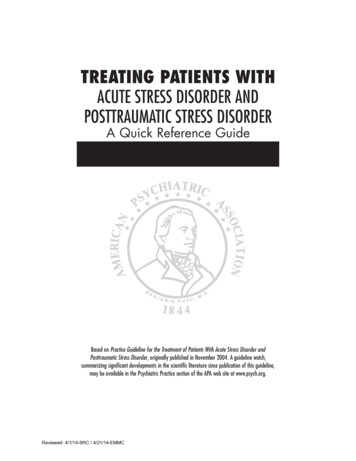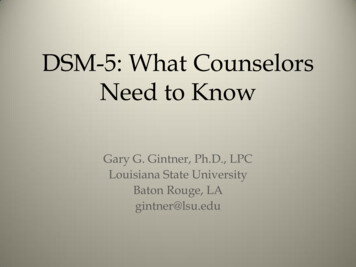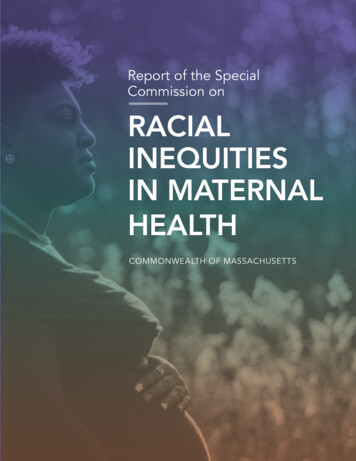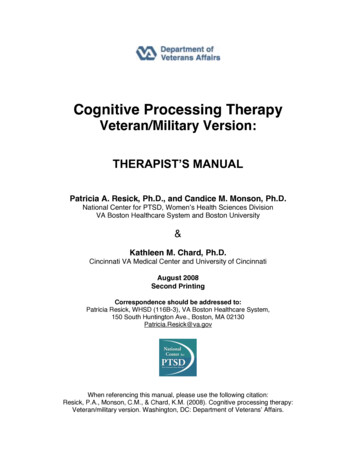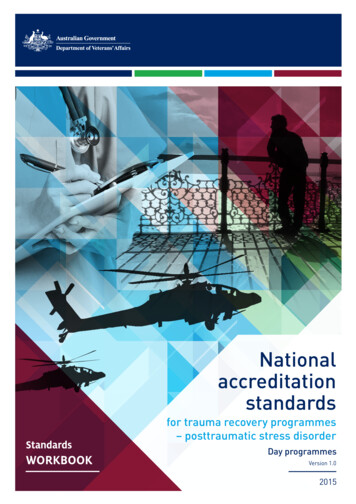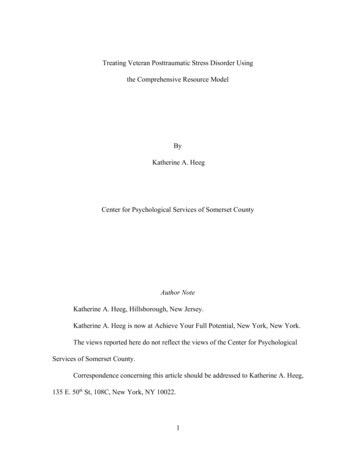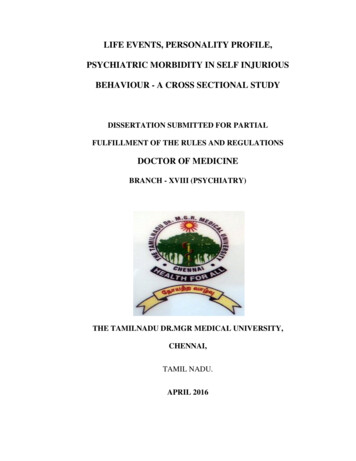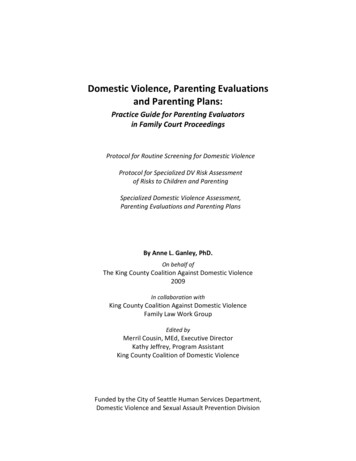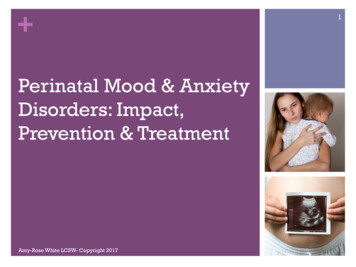
Transcription
View metadata, citation and similar papers at core.ac.ukbrought to you byCOREprovided by University of Missouri, St. LouisUniversity of Missouri, St. LouisIRL @ UMSLDissertationsUMSL Graduate Works6-22-2011Maternal Posttraumatic Stress Disorder, Parenting,Family Functioning, and Child OutcomeDesiree Alana SutherlandUniversity of Missouri-St. LouisFollow this and additional works at: https://irl.umsl.edu/dissertationPart of the Psychology CommonsRecommended CitationSutherland, Desiree Alana, "Maternal Posttraumatic Stress Disorder, Parenting, Family Functioning, and Child Outcome" (2011).Dissertations. 429.https://irl.umsl.edu/dissertation/429This Dissertation is brought to you for free and open access by the UMSL Graduate Works at IRL @ UMSL. It has been accepted for inclusion inDissertations by an authorized administrator of IRL @ UMSL. For more information, please contact marvinh@umsl.edu.
MATERNAL POSTTRAUMATIC STRESS DISORDER, PARENTING, FAMILYFUNCTIONING, AND CHILD OUTCOMEbyDésirée A. SutherlandM.A., Psychology, University of Missouri – St. Louis, 2007B.A., Psychology, University of Missouri – Columbia, 2005A DISSERTATIONSubmitted to the Graduate School at theUNIVERSITY OF MISSOURI – ST. LOUISIn partial fulfillment of the requirements for the degreeDOCTOR OF PHILOSOPHYinPSYCHOLOGYMay 2011Advisory committee:Steven E. Bruce, Ph.D.ChairpersonTara Galovski, Ph.D.Committee MemberZoë D. Peterson, Ph.D.Committee MemberKristin Carbone-Lopez, Ph.D.Committee Member
Maternal PTSD2Table of ContentsTitle Page . 1Abstract . 4IntroductionPosttraumatic Stress Disorder Prevalence .7Theoretical Conceptualizations of PTSD .9Effects of Paternal Posttraumatic Stress Disorder on Children 15Importance of the Mother in the Family System .21Observed Effects of Maternal Trauma and PTSD on Children and the Family23Summary and Study Objectives . .28Hypotheses .29MethodsParticipants 29Measures 32Procedure .35ResultsDescriptive Statistics .37Analyses utilizing the entire sample .41Hypothesis 1 .41Hypothesis 2 .43Analyses utilizing the online sample .Hypothesis 1 .4545
Maternal PTSD3Hypothesis 2 . .47Discussion . 48References .57Tables .76
Maternal PTSD4AbstractAlthough a good deal of research has been conducted examining the effects of parentalpsychopathology of various types (i.e. maternal and paternal depression andschizophrenia, paternal PTSD), very few studies have investigated the influence ofmaternal PTSD on mothers’ parenting and their children’s behavioral and psychologicalfunctioning. This paucity of research is in spite of the fact that women exhibit higherlifetime PTSD prevalence rates than men. The current study examined the influence ofmaternal PTSD and trauma on mothers’ parenting, family functioning, and children’spsychological well-being in a sample of 125 mothers and 34 mother-child dyads. Mothersprovided self-report information regarding their lifetime history of traumatic events,current PTSD symptoms, current parenting beliefs, and beliefs about the currentfunctioning of their family. Mothers also reported on the current psychologicalfunctioning of their oldest child. Analyses revealed that mothers in the PTSD groupreported significantly worse parenting satisfaction and efficacy, and family problemsolving, communication, and general functioning than did mothers in the Non-traumagroup. Mothers in the PTSD group also reported that their children suffer fromsignificantly more internalizing and total psychological problems than children ofmothers in the Non-trauma group. Mothers who had experienced a trauma but did notsuffer from PTSD reported significantly worse family problem-solving and child totalproblems than mothers in the Non-trauma group. These results suggest that although alifetime history of traumatic experiences may negatively impact mothers’ parenting,
Maternal PTSDfamily functioning, and the psychological well-being of their children to a slight degree,the presence of PTSD following these experiences is even more detrimental.5
Maternal PTSD6Maternal Posttraumatic Stress Disorder, Parenting, Family Functioning, and ChildOutcomePast research has linked parental psychopathology in general to a number ofnegative child outcomes, including increased incidence of psychopathology, behavioralproblems, and academic and social difficulties (Ancharoff, Munroe, & Fisher, 1998;Dickstein et al., 1998; Downey & Coyne, 1990; Kuperman, Schlosser, Lidral, & Reich,1999). Although broad, the parental psychopathology literature has been historicallybiased in certain respects. Research abounds on the effects of paternal PosttraumaticStress Disorder (PTSD) on parenting style and child outcome, while research examiningsimilar effects of maternal PTSD is relatively rare. This dichotomy is counterintuitive inthat studies of the prevalence of PTSD in the general population have shown that womendevelop PTSD following a trauma at significantly higher rates than do men (Kessler,Sonnega, Bromet, Hughes, & Nelson, 1995; Breslau et al., 1998). Further, it has beennoted that women generally tend to play an integral role in the raising of their childrenand are more often relied upon for emotional support (Bornstein, 1995; Collins &Russell, 1991; Russell & Russell, 1987).Findings of previous studies suggest that children of fathers with PTSD are atincreased risk for a variety of psychological and behavioral difficulties (Caselli & Motta,1995; Davidson, Smith & Kudler, 1989; Harkness, 1991; Jacobsen, Sweeney, & Racusin,1993; Matsakis, 1988; Parsons, Kehle, & Owen, 1990). In addition, maternal depressionand the experience of maternal trauma have been linked to adverse child outcome(Downey & Coyne, 1990; Holden & Ritchie, 1991; Levondosky & Graham-Bermann,
Maternal PTSD72000; Rossman & Rea, 2005). Taken together, these findings, coupled with informationregarding PTSD prevalence and the importance of the mother in child rearing wouldseem to suggest that the topic of maternal PTSD is a pertinent area of research that hasbeen largely overlooked. This study proposes to investigate the influence of maternalPTSD diagnosis on mothers’ reports of child behavior and psychopathology, mothers’parenting satisfaction and competence, as well as family communication, problemsolving, and general functioning.Posttraumatic Stress Disorder PrevalencePTSD is a psychological disorder that may be developed following the experienceof a traumatic event that engenders feelings of fear, helplessness, and horror in its victim.The diagnosis of PTSD necessitates the experience of symptoms falling into threeclusters: reexperiencing, avoidance, and hyperarousal. Results from the NationalComorbidity Survey indicate that PTSD is highly prevalent in the general population(Kessler, Sonnega, Bromet, Hughes, & Nelson, 1995). Indeed, of the 5877 respondentswho were interviewed for this study 7.8% (5% of men and 10.4% of women) wereestimated to have a lifetime history of PTSD. As is evident in the findings noted byKessler, et al. (1995), women have been shown to experience PTSD at much higher ratesthan men (Breslau, Davis, Andreski, Peterson, & Schultz, 1997; Breslau et al., 1998;Norris, 1992). This trend appears to be consistent across cultures and has been observedin spite of the findings that men report experiencing higher numbers of traumatic events,and women and men differ in the types of traumatic events they experience (Amir & Sol,1999; Breslau et al., 1998; Flett, Kazantzis, Long, MacDonald, & Millar, 2004;
Maternal PTSD8Gavranidou & Rosner, 2003; Kessler et al., 1995; Norris, Foster, & Weisshaar, 2002;Norris, Murphy, Baker, Perilla, Rodriguez, & Rodriguez, 2003; Stein, Walker, Hazen &Forde, 1997).With regard to gender differences in type of traumatic experience, Gavranidouand Rosner (2003) noted that their review of the extant literature reveals that womenmore often experience sexual abuse and rape whereas men more often report having beenvictimized through physical attacks or serious accidents. They further reported that bothmen and women are more likely to develop PTSD following a sexual trauma such asabuse or rape, whereas women develop PTSD at higher rates than men for traumas thatinvolve interpersonal assault that is not sexual in nature, as well as events such as lifethreatening accidents and natural disasters. Indeed, data from both the NationalComorbidity Survey and the Detroit Area Survey of Trauma indicate that genderdifferences in the PTSD prevalence rate are significant even when trauma type iscontrolled for (Norris, Foster, & Weisshaar, 2002).These gender differences have also been noted in studies examining theprevalence of PTSD cross-culturally. For example, Norris, Perilla, Ibanez, and Murphy(2001) found that after experiencing a hurricane, Mexican women were much more likelyto develop PTSD than were Mexican men. While a similar gender difference was foundwhen comparing Anglo-American and African-American women and men, thisdifference was not nearly as large for either of these populations as that noted within theMexican sample. The authors hypothesized that gender differences in PTSD wereincreased in the Mexican sample due to the much more traditional views of masculinity
Maternal PTSD9and femininity fostered by the Mexican community as compared to that of both theAnglo- and African-American communities. Further, Norris et al. (2001) reported that thegender gap in PTSD rates was smaller within the African-American sample than in theAnglo-American sample. This difference was also attributed to differences in genderroles within the communities (i.e. Anglo-Americans are thought to typically adhere morestrictly to traditional gender roles than do African-Americans). Additional studies citedby Norris et al. (2002) have also shown that Mexican women and Chinese Americanwomen are more likely to develop PTSD following a trauma (Norris, Murphy, Baker, &Perilla, 2000; data from the Chinese American Psychiatric Epidemiology Study madeavailable to the authors by the principal investigator, David Takeuchi).Theoretical Conceptualizations of PTSDResearchers have proposed a number of theories to account for the developmentof PTSD in some survivors of traumatic events. Most relevant to the following discussionare the Diathesis-Stress Model of PTSD (McKeever & Huff, 2003), a cognitivevulnerability model (Feeny & Foa, 2006) and the Learning/Conditioning Model (Keane& Barlow, 2004).McKeever and Huff (2003) posit that the residual stress an individual experiencesas a result of a traumatic event interacts critically with existing individual factors(diatheses) to determine that individual’s likelihood of developing PTSD. Specifically,the residual stress described by McKeever and Huff (2003) constitutes the “immediateand lingering effects of experiencing a traumatic event” (p. 239). The authors also
Maternal PTSD 10propose that the severity of the traumatic event experienced is directly related to thepsychological outcome. That is, the experience of more low-grade traumatic events thatdo not precipitate the development of PTSD can be incorporated into that person’sdiathesis constellation.With regard to diatheses, this particular model posits the existence of two types ofdiatheses: ecological and biological. Ecological diatheses include those risk factors thatare linked to the individual’s psychological self and surrounding environment. Thesediatheses are thought to be important insomuch as they may predispose individuals todevelopment of maladaptive cognitive patterns hypothetically associated with a greaterlikelihood of developing PTSD following a trauma.Biological diatheses on the other hand are described as risk factors of a structuraland neurochemical nature (McKeever & Huff, 2003). Biological diatheses maypotentially alter an individual’s physiological and neurological response to the trauma,thereby increasing the likelihood that they may develop PTSD. Heritable genetic markersconstitute one form of biological diathesis and a number of studies have been conductedexamining genetic vulnerability for the development of PTSD following a trauma.Researchers have generally found that some specific allelic markers are associated withincreased risk of PTSD, lending some weight to the hypothesis that biological diathesesplay an important role in the development of PTSD (Freeman, Roca, Guggenheim,Kimbrell, & Griffin, 2005; Lawford et al., 2003; Lee et al., 2005; Segman et al., 2002;Young et al., 2002).
Maternal PTSD 11These three individual variables (residual stress, ecological diatheses, andbiological diatheses) interact to increase or decrease an individual’s chances ofdeveloping PTSD following a trauma. Individuals with higher degrees of both ecologicaland biological diatheses need not experience as severe a traumatic stressor in order toresult in the development of PTSD. In contrast, those individuals who possess fewecological and biological diatheses may be more resilient in the face of more severeresidual stress resulting from a trauma.In relation to the discussion of parental psychopathology and child outcome, onemight conceptualize the experience of being raised by a parent with a severe mentalillness as an ecological stressor. Specifically, children may learn belief systems anddevelop certain worldviews in response to the beliefs and opinions espoused by a parentwith PTSD. Indeed, an information-processing theory of the effects of parental PTSD onchildren suggests that because children’s schemata are directly influenced by earlyinteractions with their caregivers, parents’ distorted and maladaptive beliefs about self,others, and the world may be transmitted to their children (Janoff-Bulman, 1992;McCann & Pearlman, 1990). If children of parents suffering from PTSD hold distortedand maladaptive beliefs prior to experiencing a traumatic event themselves this mayincrease the likelihood that they will develop PTSD subsequent to that event. It alsoseems likely that the ecological diathesis of growing up with a parent diagnosed withPTSD may also increase the child’s vulnerability to other mental disorders (i.e. majordepressive disorder, generalized anxiety disorder) when less traumatic stressors occur.That is, given that the experience of being raised by a PTSD positive parent constitutes an
Maternal PTSD 12ecological diathesis, children of these parents who experience a less severe residualstressor may be at greater risk for developing other non-trauma related disorders thanpeers raised by healthy parents.The conceptualization of a parent’s maladaptive or distorted beliefs surrounding atraumatic experience constituting an ecological stressor for a child is further supportedwhen one considers a cognitive conceptualization of the development and maintenance ofPTSD. From this standpoint, an individual’s beliefs about self, others, and the world areexceptionally important in whether or not an individual develops PTSD following atraumatic event. Foa and her colleagues have argued that the holding of overly rigidbeliefs may predispose individuals to the development of PTSD (Foa & Riggs, 1993; Foa& Jaycox, 1999). That is, if an individual holds very rigid beliefs about self, others, andthe world (whether positive or negative) prior to the trauma, then that individual mustfind a way to either fit their traumatic experience into their pre-existing belief structure oralter that structure to accommodate the traumatic experience. The beliefs resulting fromthis assimilation or accommodation of the trauma may make it particularly difficult forthat individual to successfully recover.If the influence of maladaptive cognitions is indeed a major factor in thedevelopment and maintenance of PTSD (as has been indicated by past research; Foa,Ehlers, Clark, Tolin, & Orsillo, 1999; Warda & Bryant, 1998) then this would seem tosupport the notion that parental beliefs play an important role in the relationship betweenparental PTSD and child psychological functioning. If one conceptualizes posttraumaticcognitions as a particularly important part of PTSD and also entertains the idea that
Maternal PTSD 13children’s developing schemas are influenced by those of their parents this would seem tosuggest that at least some of a parent’s posttraumatic beliefs will have an effect on his orher children.A more behaviorally oriented theory of PTSD that may have a bearing on thisdiscussion is Keane and Barlow’s (2004) Learning/Conditioning Model. This modelemphasizes the idea that upon exposure to a traumatic stressor, individuals experienceintense basic emotions and/or physiological reactions (i.e. “true alarms”) in response to athreat situation, rage or distress resulting from the overwhelming effects of a traumaticevent. These experiences then lead to the person developing “learned alarms” that occurwhen the individual is exposed to situations (be they external or internal) that symbolizeor resemble aspects of the traumatic event. This conditioning hypothesis presumablyexplains both the reexperiencing and hyperarousal symptoms of PTSD. Keane andBarlow (2004) also theorize that the numbing of general responsiveness in individualssuffering from PTSD may be due to a desire to avoid aversive emotional reactions of anykind. While individuals exposed to a traumatic event may learn that a particularemotional or physiological reaction is appropriate in response to a particular stressor,these responses may cease to be appropriate or functional for the individual later in life.These “learned alarms” as well as maladaptive coping strategies utilized by the traumasurvivor may also be transmitted to children of PTSD sufferers via modeling.Similar to the information-processing theory mentioned previously (JanoffBulman, 1992; McCann & Pearlman, 1990), Ancharoff, Munroe, & Fisher (1998) havecited four mechanisms of secondary trauma transmission from parents to children. The
Maternal PTSD 14first of these is silence on the part of the PTSD sufferer. When the parent remains silentabout the experience and aftereffects of the trauma, rules, myths, and metamessages arethought to be communicated to the child without the benefit of an explanation regardingthe origins of these systems of belief. On the opposite end of the disclosure spectrumfrom silence is the second mechanism, overdisclosure. Ancharoff and her colleagues(1998) suggest that direct disclosure of traumatic experiences (particularly withoutconcomitant affect) may traumatize children and other family members. Identification isthe third mechanism of trauma transmission posited by Ancharoff et al. (1998). Childrenmay feel responsible for their trauma survivor parent’s distress leading to the childattempting to behave in such a way as to lessen the parent’s symptoms. Alternately, if thechild over-identifies with the parent in an attempt to gain acceptance and recognition, theparent’s symptoms may be transferred through observation and modeling. Finally,Ancharoff et al. (1998) describe the process of reenactment as a possible mechanism ofsecondary trauma transmission. The parent may engage the child in activities orinteractions that serve to transmit lessons that s/he learned as a result of his/her traumaticexperience. This is theoretically accomplished when the child is made to feel similar tothe way the parent felt at the time of his/her initial traumatic experience. AlthoughAncharoff et al. (1998) provide qualitative evidence for their theory of traumatransmission no empirical studies have demonstrated that children of trauma survivors areaffected via these specific pathways.In spite of the lack of empirical evidence to support Ancharoff et al.’s (1998) fourmechanisms of trauma transmission, this theory does compliment the cognitive
Maternal PTSD 15conceptualization of PTSD development mentioned previously. In the event that a parentwishes to incorporate posttraumatic beliefs into the messages and lessons conveyed to achild it seems plausible that that parent might utilize one or more of the aforementionedmechanisms (i.e. overdisclosure, reenactment) in an attempt to do so.Effects of Paternal Posttraumatic Stress Disorder on ChildrenA number of problematic outcomes have been demonstrated for children offathers suffering from PTSD. These include increased risk for development of PTSDfollowing their own experience of a traumatic stressor, higher levels of behavioraldisturbance including diagnostically significant pathological behavior, and endorsementof unhealthy or biased worldviews. In addition, fathers with PTSD have been shown tohave disrupted or pathologized relationships with their children, a variable that may act asa mediator in the relationship between paternal PTSD and child psychopathology andbehavior.With regard to increased risk of developing PTSD following the experience of anunrelated traumatic stressor Solomon, Kotler, & Mikulincer (1988) found that LebanonWar veterans who had at least one parent who had survived the Holocaust were morelikely to develop PTSD following combat than were veterans whose parents were notHolocaust survivors. In addition, of those soldiers who did develop PTSD, secondgeneration trauma survivors attained less lasting and complete recovery than did nonsecond generation soldiers. A number of other studies have also shown that adult childrenof trauma survivors are less well-adapted following stressful and traumatic experiences
Maternal PTSD 16and are at greater risk for developing PTSD (Rosenheck & Fontana, 1998; vanIJzendoorn, Bakermans-Kranenburg, & Sagi-Schwartz, 2003).At this point the etiology of these intergenerational effects of trauma and PTSD isunclear. Given the heritability of many mental illnesses, some researchers havehypothesized that certain genetic markers and structural differences may be inherited bychildren of PTSD sufferers, constituting a biological risk factor for the development ofPTSD following the experience of a traumatic stressor (that is, a biological diathesis). Anumber of studies have been conducted in an attempt to test these hypotheses and haveyielded results indicating that PTSD may indeed be a heritable disorder. Family and twinstudies have supported the notion that some biological risk factor predisposes individualsto the development of PTSD following a trauma (Davidson et al., 1985; Davidson,Tupler, Wilson & Connor, 1998; True et al., 1993). In the interest of isolating the specificgenes associated with this observed vulnerability, researchers have endeavored toconduct association studies. Some of these studies have implicated variations in thedopaminergic system generally and the presence of the DRD2A1 allele specifically(Lawford et al., 2003; Segman et al., 2002; Young et al., 2002) while some have failed tofind a connection between the development of PTSD and the presence of the DRD2A1allele (Gelernter et al., 1999). Further research has also indicated that the presence of theserotonin transporter promoter gene polymorphism and the apolipoprotein E mayconstitute risk factors for the development of PTSD and the experiencing of more severereexperiencing symptoms and impaired memory function (Freeman, Roca, Guggenheim,Kimbrell, & Griffin, 2005; Lee et al., 2005).
Maternal PTSD 17In addition to the aforementioned studies suggesting a relationship betweenpaternal PTSD and PTSD development in children, a number of studies have examinedthe link between paternal PTSD and child behavior. Ancharoff, Munroe, and Fisher(1998) conducted a qualitative review of past research on the intergenerationaltransmission of trauma. These authors reported that children of Vietnam veteransdisplayed difficulties in one or more areas of functioning. Results of these and otherstudies suggest that children of veterans with PTSD receive more psychiatric treatment,display problems with a diverse array of psychological and behavioral disorders, andexhibit impaired social and academic functioning (Davidson, Smith & Kudler, 1989;Rosenheck & Nathan, 1985). Research examining therapists’ perceptions of childrenwhose fathers are suffering from PTSD also indicates that these children experience asignificant amount of psychological difficulties, behavioral disruption, social andacademic problems, and impaired relationships with their fathers (Jacobsen, Sweeney, &Racusin, 1993; Matsakis, 1988). Further, veterans themselves have been shown to viewtheir children as more disturbed than do fathers without PTSD (Harkness, 1993; Klaric etal., 2008; Parsons, Kehle, & Owen, 1990). In a study conducted by Caselli and Motta(1995), the presence of paternal PTSD and combat level was found to account for 33.6%of the variance in child behavior problems. When combat level was held constant, PTSDwas found to be the primary predictor of child behavior problems (Caselli & Motta,1995).Consistent with the aforementioned findings regarding children of veterans withPTSD, similar psychological difficulties have been noted in studies conducted with adult
Maternal PTSD 18children of Holocaust survivors. Specifically, these children have been found to exhibitheightened levels of self-criticism, foreboding, and guilt, as well as anger managementdifficulties and delinquent behavior (De Graaf, 1975; Felsen & Erlich, 1990; Nadler,Kav-Venaki, & Gleitman, 1985). Further, these adult children reported difficult andpathologized relationships with their trauma survivor parents (Felsen & Erlich, 1990).In addition to an increased vulnerability to PTSD as well as heightened emotional,behavioral, social and academic difficulties, children of fathers with PTSD have alsobeen shown to hold somewhat distorted beliefs about the world that match their parents’beliefs following their traumatic experiences. Ancharoff et al. (1998) reported that pastanecdotal studies have shown children of Holocaust survivors to hold beliefs seeminglytransmitted from their parents. These include the belief that the world is not a secureplace, a belief that the future is uncertain, a certainty that evil exists in the world, and thebelief that their parents were fragile, despite outward appearances (Epstein, 1979).Further anecdotal evidence has been noted by Doreleijers and Donovan (1990) whoinvestigated the belief systems of children of parents interred in Japanese CivilInternment Camps. These authors theorized that parents who have experienced a traumamay feel the need to educate their children about the true nature of the world in order toequip them with the strategies that ultimately helped them to survive the trauma. Thesekinds of messages about self, others, and the world may be transmitted to the childthrough a variety of mechanisms within the family as noted by Ancharoff et al. (1998)and detailed previously in this paper.
Maternal PTSD 19An additional effect of paternal PTSD concerns the presence of disrupted and/orpathologized father-child relationships. In her survey of counselors from 189 VietnamVeteran Outreach Centers, Matsakis (1988) reported that emotional distancing anddetachment on the part of fathers often lead to feelings of alienation and rejection in theirchildren. On the other hand, children who become enmeshed with their veteran fathersmay develop secondary traumatization (as indicated through distortions in worldview)leading them to assume a “rescuer” role with relation to their fathers. Children whodisplay these relational patterns are typically exposed to more details of their fathers’traumas than are those children whose fathers are more distant and detached (Ancharoffet al., 1998; Matsakis, 1988; Rosenheck & Nathan, 1985). Jurich (1983) also observedhigh incidences of enmeshed parent-child relationships in families of Vietnam veterans,leading to difficulties with identity development for the child, particularly duringadolescence. Indeed, veterans’ relationships with their children have been noted to becontrolling, overprotective, and demanding (Harkness, 1993) and still other studies havealso cited the presence of enmeshed relationships between veterans and their children(Haley, 1984; Harkness, 1991; Rosenheck, 1986).Parenting satisfaction has also been shown to be adversely affected by thepresence of paternal PTSD. Ruscio, Weathers, King, and King (2002) found that Vietnamtheater veterans reporting severe emotional numbing as one component of their PTSDdiagnosis experienced less positive sharing and contact with their children. In addition,these veterans reported greater levels of disagreement from their children and diminishedoverall parent-child relationship quality (Ruscio, et al., 2002). These findings were
Maternal PTSD 20echoed by Samper, Taft, King, and King (2004) in their examination of the surveyresponses of 250 male Vietnam veterans from the National Vietnam VeteransReadjustment Survey. These authors found that avoidance and emotional numbingsymptoms were most strongly associated with decreased parenting satisfactionindependent of veteran partner violence, major depression, and alcoholabuse/dependence. In addition, higher levels of PTSD symptom severity weresignificantly associated with decreased parenting satisfaction (Samper, et al., 2004).Similarly, a study examining the effects of PTSD symptoms among National Guardsoldiers deployed to Iraq revealed that more severe PTSD symptomatology wasassociated with greater perceived parenting challenges independent of the effect of PTSDon couple adjustment (Gewirtz, Polusny, DeGarmo, Khaylis,
IRL @ UMSL Dissertations UMSL Graduate Works 6-22-2011 Maternal Posttraumatic Stress Disorder, Parenting, Family Functioning, and Child Outcome . Individuals with higher degrees of both ecological and biological diatheses need not experience as severe a traumatic stressor in order to result in the development of PTSD. In contrast, those .
